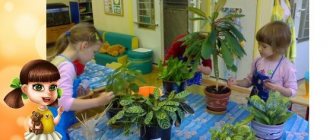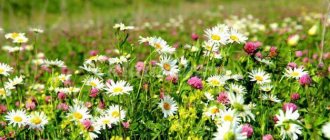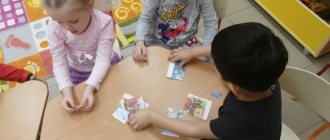Program content.
Introduce the pupils to a plant that is new to them - a friendly family, and teach them to describe its leaves in more detail. To consolidate and supplement children’s knowledge about plant care techniques: teach them to distinguish between watered (dark, damp soil) and unwatered (light, dry soil) plants, wipe not only its leaves, but also the pot with the saucer. Develop the ability to perform work 8 in a certain sequence. Continue to cultivate interest and love for plants, the desire to care for them. Repeat the names of the plants.
Preparing for the lesson.
On the teacher’s table there is a friendly family plant (two copies), a watering can with water, a basin with water, and a cloth. Children's chairs are placed in a semicircle in front of the table. At the other end of the room, on tables, chairs and on the floor there are plants with dense leathery leaves, basins with water, and rags. Each plant should stand on oilcloth.
Progress of the lesson.
Children sit on chairs. The teacher shows indoor plants known to the children (ficus, clivia) and asks them to remember their names. After listening to the children’s answers, he continues: “Today we will look at a new plant called a friendly family. (Children repeat the name.) Let’s look at it carefully.”
The children answer the teacher’s questions, determine the size of the plant’s leaves, their shape, and color. Then the surface of the sheet is determined by touch. The teacher summarizes the children’s answers and tells them the permanent location of the new plant. Then he asks: “Children, how do we care for our plants? What are we doing? (We water and wipe the leaves.) There are two plants in front of you. Look: what kind of soil does this plant (show), what color? (Dark.) Galya and Vitya, come and touch the ground. What does it feel like? (Raw.) Now look at the soil of the other plant. Same color? (No, light one.) Petya and Kolya, come and touch the ground. What is she like? (Dry.) Which of these plants do you think has already been watered and which has not? That's right, the first plant was watered. How can you tell if a plant needs to be watered? (By the color of the earth, to the touch.) Vova, come and water the plant that hasn’t been watered. Did Vova choose the right plant? Is he watering it correctly?
Now remember how we still care for plants, what do we do? (We wipe the leaves.) Tolya and Anya, show everyone how to wipe the leaves. Take some cloths, wet them, and wring them out. Now spread it on your hand and wipe the leaves first from above, then from below. (Children complete the task.) And now all the children will wipe the leaves of the plants, and then the pots in which they grow, and the saucers - like this (shows). When all the leaves are clean, take watering cans and water the plants that have not yet been watered today.”
The children work, and the teacher helps them with advice if necessary. Then he offers to look at the plants - how clean and beautiful they have become.
In the process of caring for plants, children are introduced to one more rule: after watering the plants, they must pour water into the watering cans and leave it until the next day.
In teaching children in the middle group, didactic games with plants and their images in pictures are used more often than in the younger group. In games, the teacher exercises children in describing plants, teaches them to compare them, naming the characteristic distinctive features of each, teaches children to name plants correctly; Classes on familiarization with plants are held 3-4 times a year.
Sample summary of the lesson “Introduction to indoor plants”
Program content. Continue to teach children to describe plants, noting the differences and similarities between them and the most characteristic features of their appearance. Teach description according to the plan proposed by the teacher. Strengthen children's knowledge of plant names. Introduce them to a new plant - balsam, give it its everyday name (light). Explain the name of the plant. Maintain and strengthen children's interest in indoor plants and observing them.
Preparing for the lesson. Select plants for viewing; put some on the table, others on the windowsills. The balsam is removed at the beginning of the lesson.
Progress of the lesson.
The children are sitting in their places. The teacher asks them to answer the questions: “What is on my table? What are these indoor plants called? What is their size? What are their leaves in shape, size, color, surface? Do plants have flowers? What are they and how many are there?” Then he shows the ficus and asks to look at it; asks the children what size it is. The children answer: “Big, looks like a tree.” Answering the teacher’s questions, they establish that the stem of this plant is straight, tall, the leaves are large, oval in shape, and dark green in color.
“What more can be said about the leaf? — the teacher asks, offering to touch the piece of paper. “What does it feel like?” That’s right, the leaf is smooth and shiny.”
After this, they summarize: what everyone said about the plant, how you can characterize the plant as a whole.
The teacher invites the children to also talk about other contrasting plants, compare them with each other in size, shape and color of leaves and other characteristics.
Next we consider balsam. The teacher, turning to the children, says: “Children, look at this new plant. It's called a light. You see that it has many small red flowers, and that is why it was called the wisp. Look at it carefully and talk about it the same way you talked about other plants. (Children look at the light and describe it.) Do you like the light? He will remain in our group. What place will we find for it? That's right, the light will grow well where there is a lot of light and sun. Now let’s compare the light and another plant - a friendly family. Are they similar? How are they different? What size are they? What kind of leaves do they have?
By asking questions, the teacher encourages children to characterize each plant as a whole, and comparing it with others makes it possible to clarify the characteristics characteristic of each plant.
At the end of the lesson, a didactic game is played. The teacher says: “Now we will play with you. One of you will drive: he will turn away, and we will hide some plant. He must find out which plant we removed. (The game is repeated 3-4 times, each time with a new driver.) Now let’s play differently: while the driver is not looking, we will rearrange the plants on the table, and he will have to find out what has changed.” (The game is also repeated several times.)
At the end of the lesson, the teacher evaluates the children’s knowledge, the children put small plants in their places.
In subsequent lessons, other versions of didactic games are used - games with drawings or postcards depicting indoor plants known to children. For example, the following tasks are given: find a plant and put its image on it; find identical plants in a group; find plants that have beautiful flowers, or those that have no flowers, etc.
In the middle group, work assignments also become more complicated - children are systematically involved in caring for and observing plants. In the process of collective work, they use not only well-known plant care techniques, but also newly mastered ones. However, even in this group, the teacher must remember that his own example, his love for plants and the ability to notice changes in their growth and development are of great importance for instilling in children an interest and love for plants. From time to time, the teacher gathers the children and draws their attention to what happened to the plants in the group. This helps to develop a sustainable interest in plants in children.
"Passport of indoor plants senior group"
BALSAM
Homeland: Eastern India. There are about 600 species. People call it touchy or Vanka wet. For the plant to bloom in winter, the temperature must be at least 15 C. Water it often in summer, and reduce watering in winter. Spray carefully, avoiding getting on the flowers. Replanted at any time of the year.
FICUS
Homeland: tropical regions of Asia and Africa. There are more than 2000 species of plants. The plant is not whimsical. Ficus is a light-loving plant. Water the ficus 1-2 times a week. In summer, the plant is sprayed daily. The plant is replanted first annually in March. Then once every 3-4 years.
By creating “clean air”, ficus helps to increase efficiency, overcome stress, and normalize sleep.
COLEUS
Homeland: tropical regions of Asia and the island of Java. There are about 150 species. A very heat-loving plant. Coleus is a light-loving plant. In summer, water every other day. In winter, water less often. On hot days, spray daily. The plant is replanted annually in the spring. volatile secretions of coleus, having phytoncidal activity, create “clean air” around, help increase efficiency and overcome stress.
NEPHROLEPIS
(Fern)
Nephrolepis is a heat-loving plant. The plant prefers bright, diffused light and must be protected from direct sunlight. The plant requires abundant watering. It is important to spray daily. Replant as they grow - once every 2 years. In people exposed to the atmosphere of volatile nephrolepis secretions, the body's defenses increase, the processes of excitation and inhibition in the cerebral cortex are normalized, performance and endurance to physical activity increase.
CHLOROPHYTUUM
Homeland: subtropics of Europe and tropics of Africa. There are about 220 species. It grows in both shade and sun, but must be protected from direct sunlight. Watering is moderate - 2-3 times a week. Be sure to spray in summer. Replant annually, mainly using transfer to a larger pot.
BEGONIA REX
Begonia is native to tropical and subtropical forests and mountainous regions of South America, Asia and Africa. What begonias don’t like is having their dormancy disturbed. Therefore, try not to move them from place to place and not touch them again. Begonia is a heat-loving plant. Begonias really do not like waterlogged soil, so they need to be watered when the top layer of soil dries 1-2 cm. Begonias do not tolerate spraying - because of it, brown spots appear on their leaves! It is recommended to replant begonias once every two years, when the pot becomes too small for them.
ZEPHYRANTHES
Its homeland is considered to be South and Central America. The genus includes more than 35 species. The flower is extremely light-loving. The plant must be watered and sprayed regularly. In autumn you need to reduce watering. At the end of winter they are replanted
and begin to water abundantly.
are propagated
at home by baby bulbs, which very quickly fill the entire pot.
DECEMBRIST
Zygocactus, also called "Decembrist" and "Christmas cactus" is a plant native to the southeastern part of Brazil. Decembrist does not like either excessive watering or drying out the soil.
In summer, the plant must be watered regularly, and in winter - moderately.
The time to replant
this plant, which must be done once every three or four years, is March-April. It can be propagated by cuttings, which easily begin to take root in water. Zygocactus is not recommended to be on a windowsill with direct and bright sunlight.
TRADESCANTIA
Homeland:
tropical and temperate regions of America.
Light:
bright diffused.
Can also tolerate direct sunlight (in limited quantities). Watering:
abundant, as the top layer of the substrate dries, in spring and summer.
In autumn and winter, watering is moderate. Air humidity:
does not play a significant role. In summer it is recommended to spray.
Transfer:
young plants once a year, adults after 2-3 years, in the spring, combined with pruning long shoots.
Reproduction:
by seeds, cuttings or dividing the bush.
HYMENOCALLIS PANCRATIUM WHITE
Its homeland is South America. In total, there are about fifty species in nature, many of which are indoor plants. Water Hymenocallis abundantly during the growing season and moderately during the dormant period. When there is little moisture, the leaves become lethargic, and an excess of moisture is detrimental to it. Hymenocallis is photophilous. Hymenocallis is replanted approximately every three to four years, and only during the dormant period.
ALOE
Aloe is ready to endure any hardships and hardships - heat in summer, cold in winter, shade and sun, long absence of water and poor rocky soil. At the same time, he is a wonderful healer, he cures everything - from a cut to consumption. In fact, agave, also known as aloe vera
, our most popular species, refuses to bloom solely due to lack of heat and light. At home (in the deserts of South Africa, on the Cape Land), from each bunch of thick twisted and prickly leaves, a rather large peduncle with a brush or spike of bright orange or yellow-red, less often white, tubular flowers grows annually.
PELARGONIA ZONAL
The species received its name for the peculiarity of the color of its leaves. A “zone” is a wide or narrow border or spot in the center of a black shade. The stems are succulent, woody at the base, and the leaves are round or heart-shaped. The best soil for them will be one that consists of equal parts of turf (or compost) soil, humus, peat and sand. Many varieties have phytoncidal properties, so they can be very useful in homes where there are children.
SANSEVIERIA
Homeland of sansevier
– tropical regions of Africa and Asia. Sansevierias are rhizomatous plants with a rosette of erect decorative fleshy leaves. For their shape and color, they are popularly called “pike tail”, “mother-in-law’s tongue”, “snake skin” and even “African hemp”. Watering is moderate - only when the soil is completely dry. Use a soil mixture of turf and leaf soil, humus, peat and sand (1:1:1:1:1). Sansevieria improves the human air environment and optimizes the biological functions of the body.
HOYA.
Wax ivy is a small, compact, although abundantly branching shrub with fleshy leaves about 2.5 cm long. Drooping umbrellas of exquisite fragrant white waxy star-shaped flowers with pinkish-red centers. Sod and leaf soil, humus, peat and sand (2:1:1:1:1).
Watering
abundant in spring and summer, moderate in autumn and winter.




